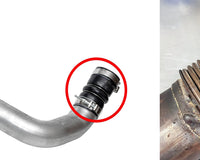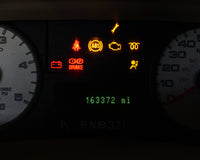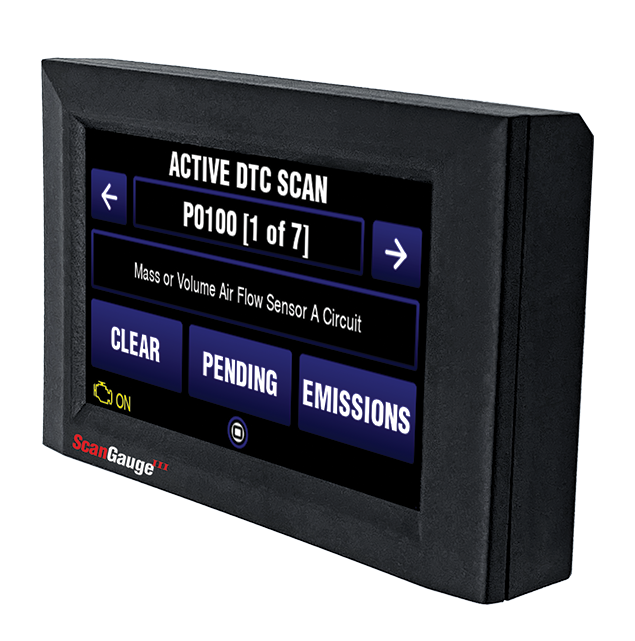Exhaust and Boost Leaks: A simple guide to finding the source.
What is a boost leak or an exhaust leak? Have a check engine light on and trouble codes such as P0401 or P0299? Simply put, a boost leak is a loss of air from an engine’s intake system and an exhaust leak is a loss of air from the exhaust system. So why does this matter? Well, boost and exhaust leaks can cause some major problems if they are not addressed in a timely manner. On a diesel engine, boost or exhaust leaks can cause an imbalance of the air-to-fuel ratio. This imbalance can cause an increase in the exhaust temperature which can lead to failure of turbochargers, injectors, and more. Either type of leak can cause a loss of power and can lead to engine overheating due to the engine having to work harder to produce the same power. These leaks can also greatly affect the fuel economy of your vehicle.
The fact of the matter is that boost and exhaust leaks are a common occurrence on modern turbo diesel engines. Some of the most common symptoms of either type of leak are: Lack of power, turbo lag, smoke from the tailpipe, check engine light, whistling, hissing, or ticking noises and poor fuel economy. Boost leaks can be accompanied by a pop or boom if one of the intercooler boots comes off or tears while under pressure. Exhaust leaks are generally more noticeable when the engine is cold. A strong exhaust smell in the cab of the truck would also indicate a possible exhaust leak.
There are a few ways to go about diagnosing exhaust or boost leaks. The first thing you should start with is to determine the symptoms that the truck is displaying. Is there smoke or a loss of power? Are there any new sounds or smells that the truck is making? Making a list of symptoms can help you determine whether the problem is due to a leak from the intake or exhaust system, or if there is something else causing the issue. There is a short list when it come to the tools needed to find a leak. The following items will be very helpful: a long piece of hose or tubing, soapy water in a spray bottle, a flashlight, a telescoping mirror, and a Bullet Proof Diesel Boost Leak Tester. You will also need to use your eyes, ears and nose.
The most common places to inspect for a boost leak is at any of the connections on the intake system. Anywhere there is a connection, there is a possibility for a leak to develop. Intercooler piping typically uses silicone rubber boots to connect the pipes to the turbocharger, intercooler and intake manifold. These boots can tear or split and the clamps that hold them on can loosen up. Most OEM intercoolers use plastic tanks attached to an aluminum core. These tanks can separate from the core and cause a boost leak. Some trucks use a rubber hose to connect the MAP sensor to the intake manifold. If this hose breaks, it will result in a boost leak as well. Failed EGR valve gaskets can also cause a boost or exhaust leak or both. One telltale sign of a boost leak is the presence of oil around the area where the leak is occurring.

Here is an example of a boost leak; A truck was pulling heavy a trailer up a steep hill and it made a loud pop followed by black smoke and loss of power, check the intercooler piping, boots, and the end tanks on the intercooler. Using the Bullet Proof Diesel Boost Leak Tester is a good way to go about finding leaks in the intake system. The leak tester helps by allowing you to check for leaks without the engine running. The boost leak tester gives you the ability to pressurize the intake and listen for leaks. With the system under pressure, you can spray soapy water on any of the connections in the intake system and if you see bubbles appear, you have found where the leak is occurring. Use a long piece of tubing or hose to listen around the area where the boost leak is suspected. The sound of rushing air escaping the intake system should be a lot louder where it is leaking than anywhere else.

The most common places to check for exhaust leaks are similar to boost leaks. Anywhere there is a connection is a possible leak spot. The mounting hardware for the exhaust manifolds on diesel engines can loosen up over time and create an exhaust leak. One of the most common areas for exhaust leaks to occur is at the up-pipes to the turbocharger. These pipes often have flexible joints built into the pipe and these joints can weaken and crack causing a leak. Other spots to look for exhaust leaks are at the EGR cooler, turbocharger inlet, EGR bypass pipe, and the exhaust back pressure sensor tube. Looking for the presence of soot will help locate the source of the exhaust leak.
An example of an exhaust leak would be a truck that makes a noticeable hiss when running and black soot on the engine firewall. You may notice the smell of exhaust in the cab of the truck. You may also have codes stored in the Powertrain Control Module (PCM) like a P0401 or P0299. To troubleshoot these symptoms, start with a visual inspection to identify the source of the soot since that is usually where the leak is occurring. If unsuccessful at visually identifying the source, start the engine and use a long piece of tubing or hose to listen around the area where the soot is located. This should allow you to identify the source. The most common spots for exhaust leaks to occur are at the up-pipes, exhaust manifolds, EGR cooler, and EGR valve. Exhaust leaks can also be found at the turbocharger, usually due to loose clamps or misaligned connections.
Whether your truck is a Ford, Ram, or GM, these methods should help you locate most exhaust or boost leaks. Don’t forget to pick up one of our Bullet Proof Diesel Boost Leak Testers to help in the diagnostic process. If you are unable to locate a leak, the problem may be caused by something else that might be affecting turbocharger or overall engine performance. In that case, further troubleshooting would be required and it is recommended to have a reputable shop take a look.










